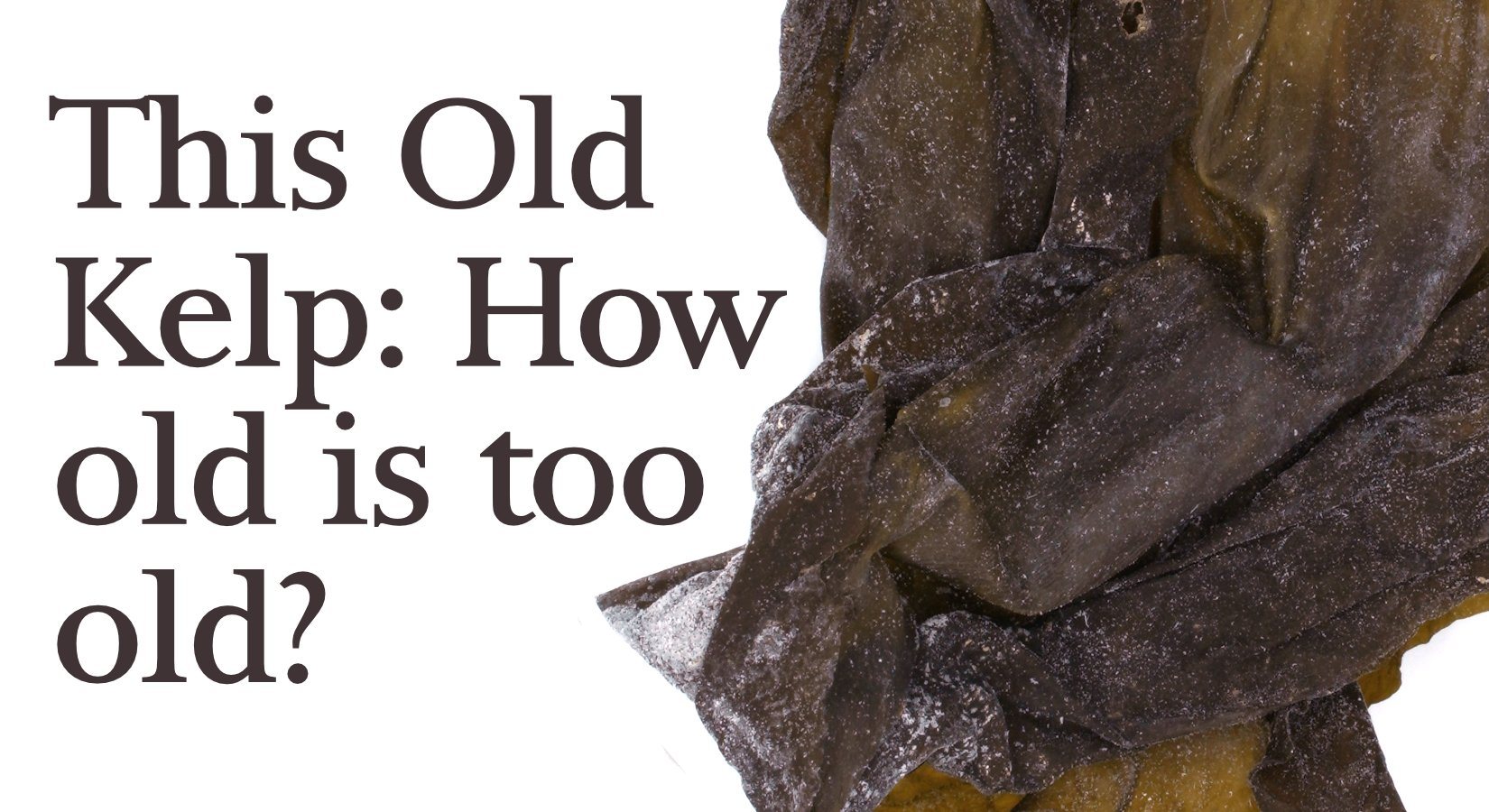Customers sometimes ask how long dried seaweed will keep and yet still be edible and nourishing. They may have rediscovered a hidden stash in the back of their cupboard, but the “best before date” was one or two years, or even more, out-of-date. Some people just want to know how much seaweed they can safely purchase and use before it “goes bad”.
Instead of purchasing in bulk, they may purchase multiple small bags or make more frequent purchases in order to ensure “freshness”. However, freshness and shelf life may not be the most important considerations when it comes to the quality of dried seaweed.
What is the shelf life of dried seaweed?
When considering shelf life, it’s important to know that dried seaweed is non-perishable if it’s properly dried and then stored in an airtight container away from heat or sunlight. Non-perishable foods are defined as those that can be stored for extended periods without refrigeration. Many food experts and other seaweed companies also use the term “indefinitely” when describing the shelf life of dried seaweed. This may make sea vegetables the ultimate survival food for a wilderness expedition, an emergency, or some future catastrophe. We always bring some on our backpacking trips!
Indefinitely can mean either an unlimited or an unspecified period of time, and in the case of dried seaweed it’s fair to say both meanings apply. Unlimited, because dried seaweed will never rot or go bad if it’s kept dry. It can be safely consumed years and years after it was first harvested. Unspecified, because scientists haven’t yet fully studied what happens to the nutrient composition and flavor of dried seaweed when it’s been stored for many years. Over a lengthy period, certain light, temperature, and oxygen sensitive substances may diminish.
These include the antioxidant vitamins A, C and E, and lipids (fats and oils); there could also be some very limited loss of elements that can off-gas under high temperature, such as iodine and bromine. However, most nutrient losses occur during the drying process itself, not during subsequent storage. At higher drying temperatures more nutrients are lost. Because our seaweed is solar or air dried at relatively low temperatures, nutrient loss and enzyme inactivation is minimized, assuring that our dried sea vegetables remain a whole, raw food.
The secret to dried seaweed’s longevity is its low water activity. In simple terms, water activity refers to the amount of water in a food not bound to other molecules. Unbound (or free) water is available (active) for chemical reactions and microbial growth, which makes aw a really important consideration for food preservation and safety.
The water activity scale runs from 0 (bone dry) to 1 (pure water), but most foods have a water activity level in the range of 0.2 for very dry foods to 0.99 for moist fresh foods. The water activity of a food is not the same thing as its moisture content. Although moist foods are likely to have greater water activity than dry foods, this isn’t always the case; many foods have exactly the same moisture content and yet have quite different water activities. Jams and jellies, for example, may appear very watery yet have an aw of less than 0.8 because the water is bound to sugar and is thus not active.
Food scientists have confirmed that most harmful bacteria can’t grow below an aw of 0.9, and that nothing can grow below aw 0.6, not even the most drought and salt tolerant of yeasts or molds. Water activity can be measured with a meter and we regularly test our sea vegetables. Our products usually test between 0.55 and .065 aw, and never above 0.7. This means they are inhospitable to all bacteria, and to all but a very few rare (and harmless) fungi.
This also makes our dried seaweed very stable, meaning chemical and enzyme reactions occur slowly, if at all. The upshot is that our dried sea vegetables are extremely shelf-stable, free of harmful micro-organisms, and remain safe and nutritious to eat for many years.
Expiration dates on seaweed

The “Best Before” date is found on a white sticker. Although this bag of laver is best used by Sept. 3, 2021, it remains tasty and nutritious for several years beyond. The number above “Best Before” is the Lot #

The date printed with the bag label is not the “Best Before” date; it’s when the label was designed. The label for this bag of laver was designed in Oct 2017
Despite this longevity, and even though it’s not legally required, all of our retail products carry a “best before” date, found on a sticker under the lot number. Retail bags may also have another date printed with the label; this date represents the label version and should not be confused as the best before date. The best before date reassures customers their seaweed was recently packaged, and it gives retailers a way to know when to rotate product on shelves or in inventory. However, the best before date is not the same as an expiration date; just because seaweed is past the best before date doesn’t mean it’s no good!
Obviously, if it’s moldy or has changed color (yellowed), then it won’t be pleasant to eat, but otherwise, dried seaweed remains safe and nutritious long past the best before date. Incidentally, don’t confuse the white, powdery substance sometimes found on whole leaf kelp, alaria or dulse as mold; it’s actually made up of salts and sugars that rise to the surface of the leaf during drying and storage, and also responsible for the distinctive umami flavor of seaweed. Vintage seaweed with this coating is often more flavorful but also more brittle, and better enjoyed in cooking rather than munched as is.
Having said the above, we should point out that not all seaweed is the same when it comes to shelf life and optimum flavor & nutrition. Our best before dates are based on many years of enjoying sea vegetables in all sorts of recipes. We’ve found that dried whole leaf is best used within five years, whereas milled product (powder and granules) is best used within three years, because milling exposes more surface area to air and light.
Nori sheets are also best used within three years because they can lose flavor and crispness if stored longer than that. On the other hand, connoisseurs say that some sea vegetables, such as kombu, actually improve with age, because aging enhances the umami flavor. In fact, some Japanese companies make a practice of aging their kombu before they sell it. We’ve found that our dulse is also better after a few months seasoning. It becomes softer and more tender after it’s cured; another example of how fresh is not always better.
Finally, a quick note about storing dried seaweed. Refrigerators are usually humid and odiferous places, so it’s not a good idea to refrigerate your dried sea vegetables. Freezing in an air tight container is fine, however, and suitable for long term storage. It’s also fine to keep your sea vegetables in a closed container on the counter or in a cupboard for day to day convenience, so long as the container is airtight and the seaweed isn’t exposed to prolonged humidity, sunlight, or high temperatures. Stock up and enjoy!



